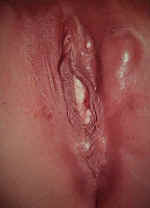|
|
Operational Obstetrics & Gynecology
Lymphogranuloma Venereum (LGV)
Lymphogranuloma venereum is an uncommon sexually-transmitted disease caused by a variant of Chlamydia trachomatis.
 Following initial exposure, there is mild, blister-like formation which is
frequently unnoticed. Within the following month, there is ulceration of the vaginal,
rectal or inguinal areas. At this stage, the disease is very painful, particularly with
walking, sitting and with bowel movements. The stool may be blood-streaked.
Following initial exposure, there is mild, blister-like formation which is
frequently unnoticed. Within the following month, there is ulceration of the vaginal,
rectal or inguinal areas. At this stage, the disease is very painful, particularly with
walking, sitting and with bowel movements. The stool may be blood-streaked.
Hard tender masses (buboes) arise in the inguinal area at this stage and are characteristic of the disease.
As the disease progresses untreated, extensive scarring in the rectal area may require surgery to enable normal bowel movements. Scarring in the vaginal area can lead to painful intercourse or make intercourse basically impossible.
Confirmation of the disease is optimally achieved with a positive Chlamydia trachomatis serotype culture from a bubo. Often, less specific tests, such as serum complement fixation test with acute and convalescent samples are used. In many operational settings, none of these tests are available and the diagnosis is made by history of exposure, visual appearance of the lesions and known prevalence in the population.
- Doxycycline 100 mg orally twice a day for 21 days, or
- Erythromycin base 500 mg orally four times a day for 21 days.
Because Azithromycin is effective against other presentations of Chlamydia trachomatis, it is likely, but unproven that use of multiple doses over several weeks would be effective against LGV.
Home · Introduction · Medical Support of Women in Field Environments · The Prisoner of War Experience · Routine Care · Pap Smears · Human Papilloma Virus · Contraception · Birth Control Pills · Vulvar Disease · Vaginal Discharge · Abnormal Bleeding · Menstrual Problems · Abdominal Pain · Urination Problems · Menopause · Breast Problems · Sexual Assault · Normal Pregnancy · Abnormal Pregnancy · Normal Labor and Delivery · Problems During Labor and Delivery · Care of the Newborn
|
Bureau of Medicine
and Surgery |
Operational
Obstetrics & Gynecology - 2nd Edition |
This web version of Operational Obstetrics & Gynecology is provided by The Brookside Associates Medical Education Division. It contains original contents from the official US Navy NAVMEDPUB 6300-2C, but has been reformatted for web access and includes advertising and links that were not present in the original version. This web version has not been approved by the Department of the Navy or the Department of Defense. The presence of any advertising on these pages does not constitute an endorsement of that product or service by either the Department of Defense or the Brookside Associates. The Brookside Associates is a private organization, not affiliated with the United States Department of Defense. All material in this version is unclassified.
This formatting © 2006
Medical Education Division,
Brookside Associates, Ltd.
All rights reserved
